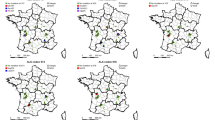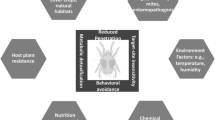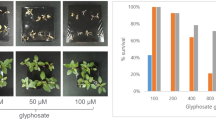Abstract
Main conclusion
Distribution of Conyza species is well correlated with human interference. Multiple herbicide resistance is caused by the attempt to overcome resistance to one mode of action by overuse of another.
Conyza canadensis (CC) and Conyza bonariensis (CB) are troublesome weeds around the world. Extensive use of herbicides has led to the evolution of numerous Conyza spp. herbicide-resistant populations. Seeds of 91 CC and CB populations were collected across Israel. They were mostly found (86 %) in roadsides and urban habitats, two disturbed habitats that had been dramatically impacted by human activities, thus we classify these species as anthropogenic. Although pyrithiobac-sodium was only used in cotton fields, 90 % of Conyza spp. populations were identified as pyrithiobac-sodium resistant, suggesting possible natural resistance to pyrithiobac-sodium. CC21 and CC17 C. canadensis populations were highly resistant to all tested ALS inhibitors due to a substitution in the ALS gene from Trp574 to Leu. They were also atrazine resistant due to a substitution in the psbA gene from Ser264 to Gly. The high level of imazapyr and pyrithiobac-sodium resistance observed in the CC10 population was due to an Ala205 to Val substitution. However, high resistance to sulfometuron methyl and pyrithiobac-sodium in population CC6 was due to a point mutation at Pro197 to Ser. All resistant plants of CC21 population showed both psbA (Ser264 to Gly) and ALS (Trp574 to Leu) substitutions, leading us to the conclusion that the attempt to overcome resistance to one mode of action by overuse of another will most likely lead to multiple herbicide resistance. Furthermore, we concluded that only individuals that carry both mutations could survive the shift between the two modes of action and overcome the fitness cost associated with the PSII resistance.





Similar content being viewed by others
Abbreviations
- CC:
-
Conyza canadensis
- CB:
-
Conyza bonariensis
- ALS :
-
Acetolactate synthase
- PSII:
-
Photosystem II multiple
- MHR:
-
Multiple herbicide resistance
- MOA:
-
Mode of action
- TS:
-
Target site
- DAT:
-
Days after treatment
- ED50 :
-
Effective dose fifty
References
Arntz AM, Delucia EH, Jordan N (2000) Fitness effects of a photosynthetic mutation across contrasting environments. J Evol Biol 13:792–803
Ashigh J, Tardif FJ (2011) Water and temperature stress impact fitness of acetohydroxyacid synthase–inhibiting herbicide-resistant populations of eastern black nightshade (Solanum ptychanthum). Weed Sci 59:341–348
Blondel J, Aronson J (1999) Biology and wildlife of the Mediterranean region. Oxford, New York, pp 328
Danin A (2014) Flora of Israel Online. Available at http://www.Flora.Huji.Ac.Il. Accessed Jan 2014
Dauer JT, Mortensen DA, Humston R (2006) Controlled experiments to predict Horseweed (Conyza canadensis) dispersal distances. Weed Sci 54:484–489
Dekker JH, Burmester RG (1992) Pleiotropy in triazine-resistant Brassica napus: ontogenetic and diurnal influences on photosynthesis. Plant Physiol 100:2052–2058
Fuerst EP, Nakatani HY, Dodge AD, Penner D, Arntzen CJ (1985) Paraquat resistance in conyza. Plant Physiol 77:984–989
Hall TA (1999) BioEdit: a user-friendly biological sequence alignment editor and analysis program for Windows 95/98/NT. Nucleic Acids Symp Ser 41:95–98
Heap IM (2014) International survey of herbicide-resistant weeds. Available at http://www.weedscience.org Accessed Jan 2014
Hirschberg J, Mcintosh L (1985) Molecular basis of herbicide resistance in Amaranthus hybridus. Science 23:1346–1349
Lehoczki E, Laskay G, Pölös E, Mikulás J (1984) Resistance to triazine herbicides in horseweed (Conyza canadensis). Weed Sci 32:669–674
Lior E, Kigel J, Rubin B (1994) Variation in response of Conyza species to atrazine, diuron and sulfometuron. In: Proceedings of the 13th Weed Science Society of Israel Conference. Weed Science Society of Israel, Rehovot, p 134
Maxwell BD, Roush ML, Radosevich SR (1990) Predicting the evolution and dynamics of herbicide resistance in weed populations. Weed Technol 4:2–13
Mechant E, Demarez T, Herman O, Bulcke R (2008) Resistance of Chenopodium album to photosystem II-inhibitors. Commun Agric Appl Biol Sci 73:913–917
Mengistu LW, Mueller-Warrant GW, Liston A, Barker RE (2000) psbA Mutation (valine 219 to isoleucine) in Poa annua resistant to metribuzin and diuron. Pest Manag Sci 56:209–217
Mengistu LW, Christoffers MJ, Lym RG (2005) A psbA mutation in Kochia scoparia (L) Schrad from railroad rights-of-way with resistance to diuron, tebuthiuron and metribuzin. Pest Manag Sci 61:1035–1042
Norsworthy JK, Ward SM, Shaw DR, Llewellyn RS, Nichols RL, Webster TM, Bradley KW, Frisvold G, Powles SB, Burgos NR, Witt WW, Barrett M (2012) Reducing the risks of herbicide resistance: best management practices and recommendations. Weed Sci 60:31–62
Park KW, Mallory-Smith CA (2006) psbA mutation (Asn 266 to Thr) in a Senecio vulgaris L. confers resistance to several PSII-inhibiting herbicides. Pest Manag Sci 62:880–885
Perez-Jones A, Intanon S, Mallory-Smith C (2009) Molecular analysis of hexazinone-resistant shepherd’s-purse (Capsella bursa-pastoris) reveals a novel psbA mutation. Weed Sci 57:574–578
Plowman AB, Richards AJ, Tremayne MA (1999) Environmental effects on the fitness of triazine-resistant and triazine-susceptible Brassica rapa and Chenopodium album in the absence of herbicide. New Phytol 141:471–485
Rubin B (1997) Herbicide resistance outside North America and Europe: causes and significance. In: Weed and Crop Resistance to Herbicides. Kluwer Academic Publishers, Dordrecht, pp 39–52
Rubin B, Yaacoby T, Schonfeld M (1985) Triazine resistant grass weeds: cross resistance with wheat herbicide, a possible threat to cereal crops. In: Proceedings of the British Crop Protection Conference - Weeds, Brighton Metropole, England, pp 1171–1178
Rubin B, Tal A, Yasuor H (2004) The significance and impact of herbicide resistance weeds—a global overview. Acta Herbol 13:277–288
Seefeldt SS, Jensen JE, Fuerst EP (1995) Feature log-logistic analysis of herbicide dose-response relationships. Weed Technol 9:218–227
Sibony M, Rubin B (2003) Molecular basis for multiple resistance to acetolactate synthase-inhibiting herbicides and atrazine in Amaranthus blitoides (prostrate pigweed). Planta 216:1022–1027
Tardif FJ, Rajcan I, Costea M (2006) A mutation in the herbicide target site acetohydroxyacid synthase produces morphological and structural alterations and reduces fitness in Amaranthus powellii. New Phytol 169:251–264
Thiel H, Varrelmann M (2014) Identification of a new PSII target site psbA mutation leading to D1 amino acid Leu218 Val exchange in the Chenopodium album D1 protein and comparison to cross-resistance profiles of known modifications at positions 251 and 264. Pest Manag Sci 70:278–285
Trainer GD, Loux MM, Harrison SK (2005) Response of horseweed biotypes to foliar applications of cloransulam-methyl and glyphosate response of horseweed biotypes to foliar applications of cloransulam-methyl. Weed Technol 19:231–236
Tranel PJ, Wright TR, Heap I (2014) ALS mutations from herbicide-resistant weeds. http://www.weedscience.com. Accessed 31 May 2014
Vangessel MJ (2001) Glyphosate-resistant horseweed from Delaware. Weed Sci 49:703–705
Weaver SE (2001) The biology of Canadian weeds. 115. Conyza canadensis. Can J Plant Sci 81:867–875
Wu H, Walker S, Rollin MJ, Tan DKY, Robinson G, Werth J (2007) Germination, persistence, and emergence of flaxleaf fleabane [Conyza bonariensis (L.) Cronquist]. Weed Biol Manag 7:192–199
Xiang Q-YJ, Thomas DT, Xiang QP (2011) Resolving and dating the phylogeny of Cornales—effects of taxon sampling, data partitions, and fossil calibrations. Mol Phylogenet Evol 59:123–138
Yu Q, Han H, Vila-aiub MM, Powles SB (2010) AHAS herbicide resistance endowing mutations: effect on AHAS functionality and plant growth. J Exp Bot 61:3925–3934
Zheng D, Kruger GR, Singh S, Davis VM, Tranel PJ, Weller SC, Johnson WG (2011) Cross-resistance of horseweed (Conyza canadensis) populations with three different ALS mutations. Pest Manag Sci 67:1486–1492
Acknowledgments
The authors would like to thank Gal Dvorkin and Ziv Kleinman for their technical assistance. The first author (MM) is the recipient of scholarships from the Teomim Foundation, the Natan Yaffe Foundation and the Zion Cohen Foundation. This study is partially supported by the Chief Scientist of the Ministry of Agriculture and Rural Development, Israel.
Author information
Authors and Affiliations
Corresponding author
Electronic supplementary material
Below is the link to the electronic supplementary material.
Rights and permissions
About this article
Cite this article
Matzrafi, M., Lazar, T.W., Sibony, M. et al. Conyza species: distribution and evolution of multiple target-site herbicide resistances. Planta 242, 259–267 (2015). https://doi.org/10.1007/s00425-015-2306-4
Received:
Accepted:
Published:
Issue Date:
DOI: https://doi.org/10.1007/s00425-015-2306-4




